April 26, 2010
Tragedy in the bathroom.
Remember those beastly expensive Italian glass tiles I naively ordered?

These are them, installed.
When I sprayed glass cleaner over my new sea-blue walls, wiping away the obscuring film of white plaster the mason had left, I could not believe my eyes. Not a single straight line! As if an ill-tempered four-year old had been hard at work.
How could I have allowed this to happen, you ask?
Well, early in the day, curiosity kept prompting me to run down two flights of stairs and check on the work. After 30 minutes of this, the mason said I made him nervous, and would I please go away and cease to bother him? The work is molto delicato, he said, and it is necessario to concentrate and be left solo.
And so away I went, full of cockeyed hope that I’d soon have a useable bathroom.
I returned to the house after two days, descended into the winery-cum-guest quarters and beheld anarchia. Thousands of tiny mosaic tiles stuck willy-nilly onto the wall. I felt like I’d been gored.
But I refused to face reality. Don’t panic, I told myself. It’s rustic. Rustic is good. It fits the theme of the wine cantina. Molto rustico! Charming in its own way. Isn’t it? Isn’t it?????
I called over a few friends to have a look. Horrid, they said, daring to utter the bald truth. Really horrid.

It doesn’t look bad from afar, though, does it? If you kind of … squint at it?
Now what do I do.
***
Click to leave a comment.
Click to subscribe.
April 12, 2010
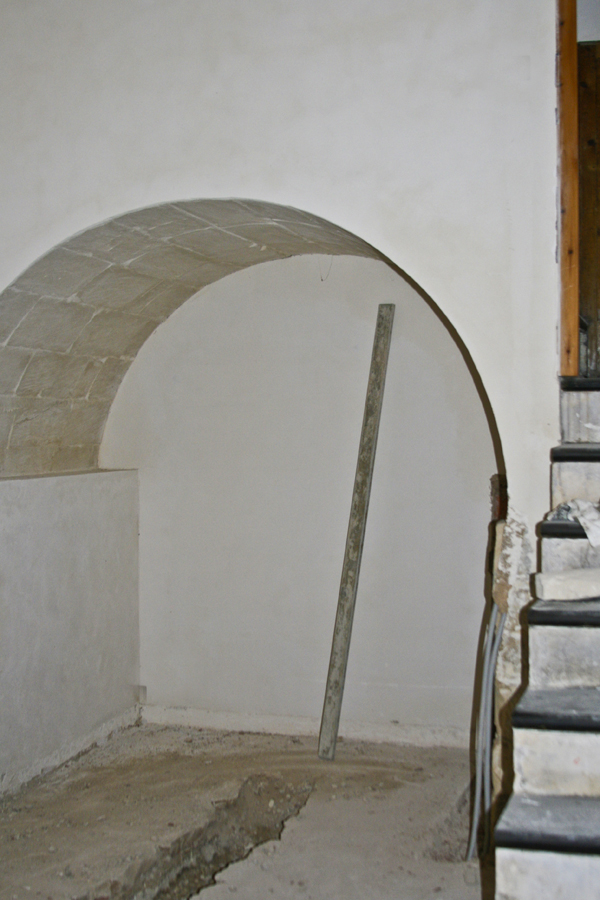
…
Into the cramped space under this arch—hardly big enough for a closet—I plan to stuff an entire bathroom: sink, toilet, shower, heat rack, mirror, towel racks. The project manager is insisting on a bidet (he says no Italian can live without one), but you’d have to put your foot in the bidet to squeeze into the shower.
This is part of the cantina, the old wine cellar that is slowly morphing into guest quarters.
I plan to expose as much stone as possible inside and above the arch. The back wall, which needs to be waterproof, will be a sea of tiny tiles. Tiles the blue of a storm-tossed Ionian Sea.
Beastly expensive tiles.
I knew nothing about the cost when I ordered. I didn’t bother to ask the price. I figured: they’re just tiles made right here in Italy, not some expensive import. How much could a few little tiles cost?
The boxes finally arrived from Milan, along with the bill. My eyes popped. I had to read it over and over. I could feel my face on fire.
“Well, you ordered glass tiles,” the project manager says. What did you expect?”
I did notice how lustrous they were, but I had no idea they were glass.
I thumb through the instruction manual that comes with the tiles. The installation looks complicated. “Are you sure the mason is up to this?” I ask the project manager. The mason seems to have perfected the art of banging and pounding, but I’ve never seen him do anything delicate with his thick, calloused hands. Do I trust him with my treasures? Has he ever installed anything of the sort?
“Non preoccuparti,” says the project manager, winking. Don’t worry.
This is the favorite phrase down here. It usually means trouble.
But who am I to argue?
***
..
Click to comment.
Click to subscribe.
April 5, 2010
…
Like spun sugar.
Snow white.
Sicilian lace, full of grace.
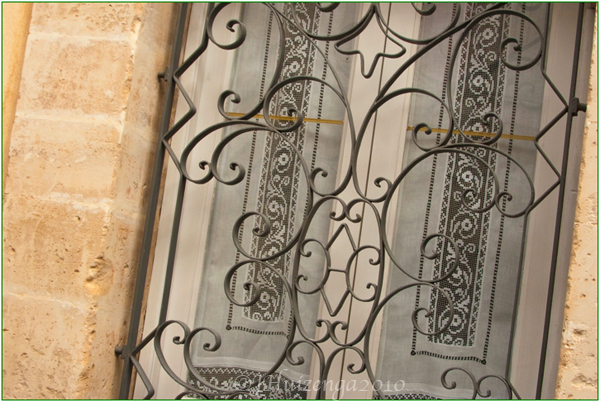

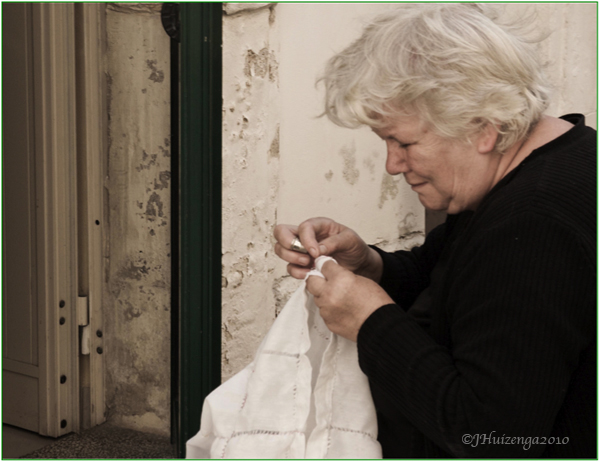
It’s women’s work, an eye-straining affair.


Twenty years ago Sicily’s shops brimmed with handmade local lace. Now it’s often made in China.
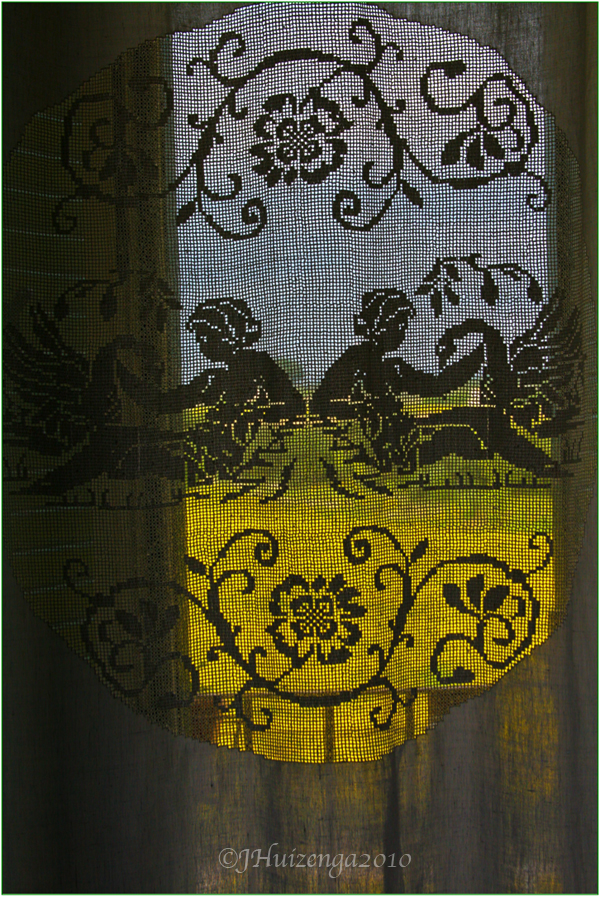
Sicily’s art of lacemaking is dying, and isn’t that a shame?
***
Note for tourists: There’s a fine little museum of Sicilian hand embroidery and lace in Chiaramonte Gulfi in southeastern Sicily (a hilltop village also known for its olive oil museum and pork restaurant, Majore).
[gmap]
March 30, 2010
Surprise! The 20th-century layers have been chipped off my walls, and I think we’ve found—in addition to big old blocks of Norman stone—some traces of Arab architecture.
North African Moors ruled Sicily for only a couple of centuries more than a millennium ago, but their influence on the island was, and is, huge.
Before I show you my little discovery, take a good look, if you will, at these keyhole-shaped doorways in North Africa.


OK, now compare those doorways with the one below in my house. The arch shape turned up when we pulled off the modern wooden door frame. Don’t you think it looks vaguely Moorish in design?
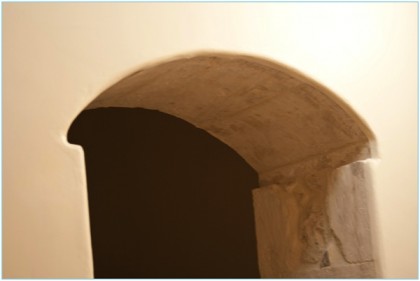 It’s not as beautiful as those North African doors, I know, and the curved thingamajig is way up top rather than in the middle of the arch, but still … it makes me wonder. It’s certainly not a pure Roman or Greek arch (more on that below). It’s not as beautiful as those North African doors, I know, and the curved thingamajig is way up top rather than in the middle of the arch, but still … it makes me wonder. It’s certainly not a pure Roman or Greek arch (more on that below).
I now have three of these vaguely Moorish arches on the top floor of my casa.
The house is a historical puzzle. The top floor, I’m quite sure, was built sometime soon after the 1693 earthquake that leveled not just Ragusa Ibla, but much of southeast Sicily. As I’ve mentioned earlier, the stone blocks in this doorway and elsewhere in the house were looted from the Norman castle that stood on this site and crumpled in that quake. (I know this only because neighbors have told me.)
So, assuming the above timeline, this means that 700 years after the Moors left Sicily, local Sicilian builders still carried traces of their Arab heritage in their builders’ DNA.
Everything here is so knotted and twisted together; it’s hard to tease out the many strands of history from all the superimposed cultures and styles. Layers upon layers—that’s what Sicily is all about.
The house becomes older the lower you go. The bottom floor used to be a cantina, a place where wine was made and stored (soon to be guest quarters). The arch down there seems Greco-Roman in style, an uninterrupted curve.

When was it constructed? Stay tuned. Maybe someday I’ll figure it out. Perhaps you have an insight?
***
For more on the Muslim rule of Sicily, click here.
***
Click to leave a comment.
Click to subscribe.
March 1, 2010
The roof’s been fixed; the rain’s been staunched.

xxx
…xxxxx
…
xxx
xxx
I turn my attention to the interior of the house.
Please find me some old stones, I implore. Vi prego. There must be stone under the many layers of plaster and wall tile. Let’s expose it!
“What do you need old stones for, anyway? asks the project manager, tossing his head impatiently. “If you want stone, we can put pietra finta, fake stone, on the walls.”
Fake stone? Could he be serious?
“It’ll be faster and cheaper than looking all over the house for old stone. It looks better, too.”
“But,” I wail, “I love old stuff! We don’t have old stuff in the Stati Uniti!!!! That’s why I’m in Sicily!”
I long to wrap history around me like a well-worn cape. Sicilians, having lived among ruins for millennia, want to shed the old cape for something flashier.
***
A week or so later, I get a call in Rome. “Non c’e pietra.” There’s no stone.
I’m stunned. This is an old Sicilian house. There has to be stone. Or have I managed to purchase the one and only stone-free house in all of Italy?
***
There’s a new twist to the plot. My husband decides to travel from the U.S. to far-flung Ragusa Ibla to see for himself what’s going on. It’s the first time he and the house will meet—nearly a year after I’ve bought it—and I’m nervous. His interest in the project has not been keen. What’ll he think?
When he arrives at our mossy-smelling home late one afternoon, there’s rubble wherever you look. He wears a fixed frown and raises an eyebrow.
Then he hunts around for a tool. There’s nothing in the house but a vintage can opener. He climbs a ladder in the salone and starts scratching at the vaulted ceiling. He claws away with his rusty little can opener until fingers start to bleed.
“So who says there’s no pietra,” he yells from atop the ladder. “Look at this.”
Peeking through the plaster is a hint of beautiful stone.
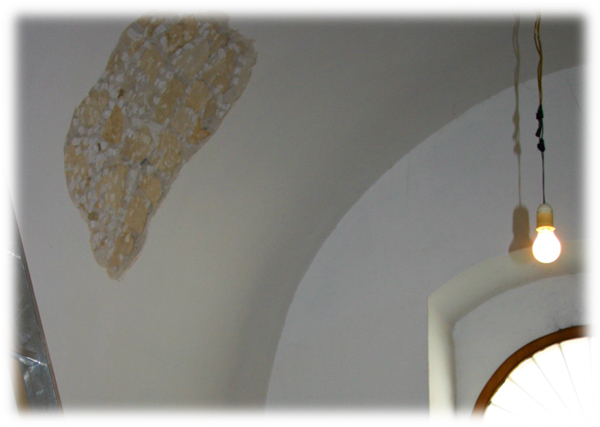
x
He comes down from the ladder and steps onto the balcony with a wan smile. Plaster has settled into his hair. The sky is full of evening light; the bells toll as if they’re going mad. The small smile transforms into a dual-dimpled grin.
x

Click to leave a comment.
Click to subscribe. (It’s free.)
|
Subscribe to Baroque Sicily
Copyright reserved -
All photos and text on BaroqueSicily are Copyright of Jann Huizenga ©2009-2015, unless otherwise noted. Material may not be copied or re-published without written permission. All rights reserved.
|











 It’s not as beautiful as those North African doors, I know, and the curved thingamajig is way up top rather than in the middle of the arch, but still … it makes me wonder. It’s certainly not a pure Roman or Greek arch (more on that below).
It’s not as beautiful as those North African doors, I know, and the curved thingamajig is way up top rather than in the middle of the arch, but still … it makes me wonder. It’s certainly not a pure Roman or Greek arch (more on that below).







